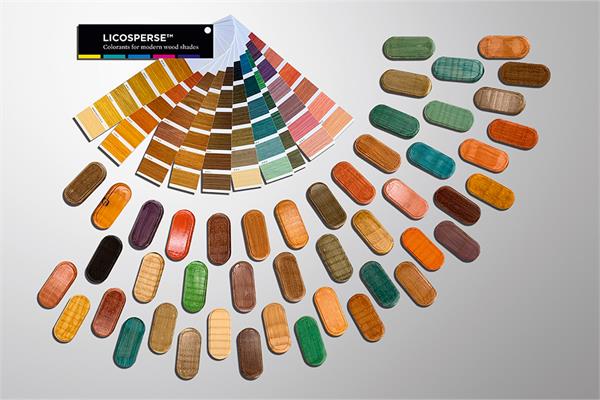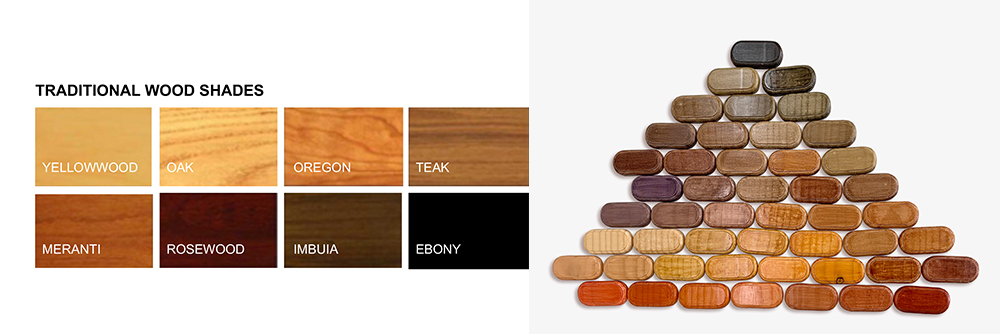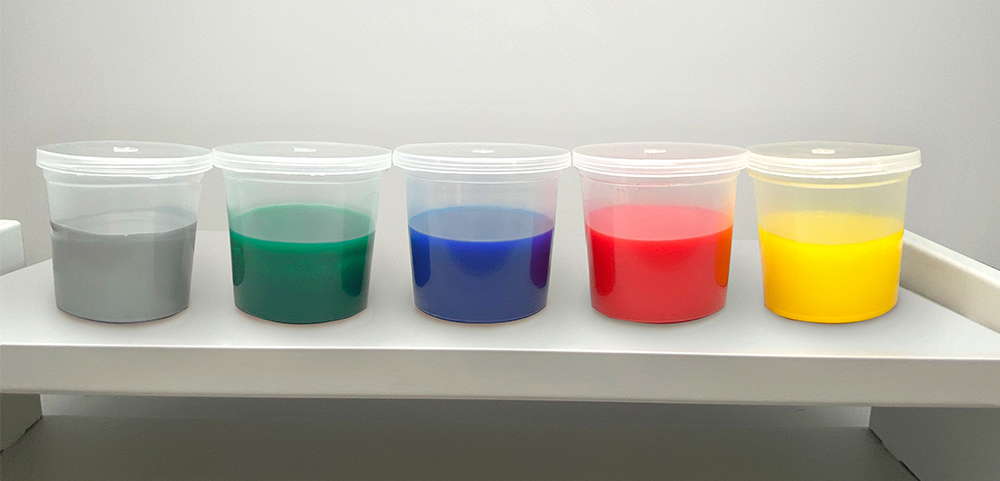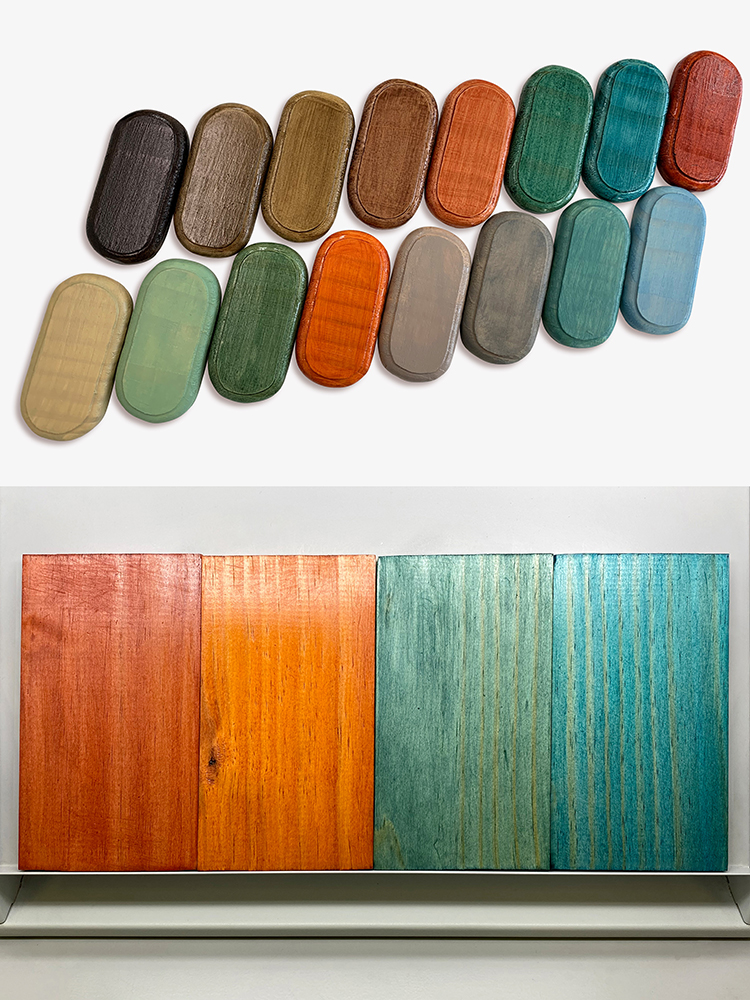
Unlike any other material, natural wood can provide a warm and beautiful atmosphere. Whether used in our residential or commercial settings, it can soften harsh lighting conditions, create a new depth in the surrounding environment, add the right touch of elegance, and can even change our moods. It is only natural then that we should want to maintain, preserve, and enhance this common building material with our colour of choice.
Both dyes and pigment preparations are typical colourants used for effective wood staining and topcoat colouration. However, unlike dyes, which are dissolved in the media, pigment preparations are suspended in a carrier solvent or can be mixed into a final topcoat (e.g., wood lacquer or varnish). Historically, dyes were the preferred choice for wood stains and topcoat colouration, as dyes dissolve instantly in the solvent and produce transparent colour. Since dyes are completely soluble in the wood stain, they penetrate deeper into the wood grains, especially in hardwoods. The trade-off with traditional dyes, however, is they are less lightfast and tend to easily migrate out of the film, hence they are not the ideal choice for high quality or high-performance wood coatings. The more innovative solution, pigment preparations, differ from dyes in that the pigment particles do not dissolve in the media, rather they are actually suspended in the wood coating formulation. By nature, the pigment particles suspended within a media, provide longer colour durability and exhibit a much lower tendency to migrate out of the coating or stain.
Traditional colours for wood stains and coatings typically trend towards transparent, yellowish, or reddish-brown shades and in many solvent based wood coatings such as staining oils, varnishes and lacquers the colourants are incorporated into the coating formulations. By doing so, the coating that is intended as a protective layer for the wood substrate also has an aesthetic appeal by virtue of the added colourant. Since different types of coating can have very specific purposes and performance requirements, the colourants used should be as versatile as possible across a multitude of coatings types. For example, to accentuate the natural grain of the wood substrate, staining oils are used because they penetrate and preserve the wood. By contrast, varnishes and lacquers are used to provide a solid layer on the surface of the wood to protect against high traffic or heavy use. By understanding the specific application and performance requirements of the wood coating, Clariant assists wood coatings manufacturers with appropriate colourant recommendations and can provide starting colour recipes to match their standard traditional shades. With the introduction of the new range of Licosperse™ pigment preparations for wood coatings, Clariant delivers a versatile replacement to traditional dyes. Licosperse pigment preparations provide improved durability and lower migration properties than dyes as well as exhibit good compatibility and in-can stability in a broad variety of wood coatings bases.

While the new Licosperse colourants have very good compatibility in staining oils, finishing topcoats and the typical solvents used in wood coatings, the type of the solvent used can play an important role in the compatibility of the pigment preparations as well. The most common solvents in wood coatings, varnishes and lacquers are mineral spirits, mineral turpentine, alcohols, lacquer thinner, toluene and petroleum-based solvents. The slow evaporating solvents such as mineral spirits and turpentine provide longer time for levelling and brushing of the coating surface. Licosperse pigment preparations are based on mineral oils and while not limited to, are compatible with the typical wood coatings products in the following table.
Licosperse pigment preparations are compatible with all wood coating products below
|
Solvents
|
Staining Oils, Seals & Furniture Waxes
|
Finishing Topcoats
|
Non-polar hydrocarbons
|
Boiled Linseed Oil
|
Alkyd based Varnishes
|
Paraffin
|
Burmese Teak Oil
|
Polyurethane Varnishes
|
Mineral Spirits
|
Danish Oil
|
Nitrocellulose Wood Coatings
|
Mineral Turpentine
|
Tung Oil
|
Solvent Based Lacquers
|
Lacquer Thinners
|
Wood Seals
|
Solvent based Acrylics
|
Ethers
|
Furniture Waxes
|
|
|
|
Water repellent waxes
|
|
Long term storage can also pose a problem for wood coatings colourants, particularly when storing pigment preparations that are incorporated into low viscosity products. To evaluate the Licosperse range of pigment preparations against any sedimentation in the containers when stored, Clariant conducted product stability and settling tests for the duration of 6 months. The results showed that the Licosperse colourants stay in suspension, however, in the event there could be a small amount of sediment after extended storage (i.e., non-use) the sediment can simply be mixed back into the formulation through gentle agitation of the container.

Because most traditional shades for wood are transparent, the coated wooden substrates will also be exposed to the UV radiation, eventually causing changes to the final appearance over time. Such changes will be influenced not only by the colorants used, but also the lightening or in some cases, the darkening of the wood surface. To offset the natural “weathering” changes in appearance, finishing coats for exterior application usually contain UV absorbers to minimise this effect. Historically, end customers desired traditional wood shades, hence those shades were predominantly available in the market because the wood coatings manufacturers were responding to their customer’s requirements.
Today, however, although traditional wood shades still dominate the market, the new trends in consumer demand are shifting towards more colourful decorative shades. The new bright and colourful shades are being used in entirely new application areas, such as kitchen cabinets, decorative accents in children’s rooms, as well as both indoor and outdoor furniture. These new colour trends require different types of colourants which still perform well in terms of compatibility, stability, light fastness, resistance to bleeding and migration out of the film, yet allow for accurate colour matching.
Clariant aids our manufacturing customers on how to create these new colour trends and to satisfy end consumer needs in the marketplace.

Clariant works closely with wood coatings customers to understand any new requirements to develop solutions which deliver the optimal end result. To achieve traditional wood shades as well as the new modern decorative shades for solvent based application, Clariant has developed new colour recipes for the Licosperse preparations range. The Licosperse series provides easy colour matching of a wide range of traditional wood shades and decorative trending colours; and as the coating’s performance and finished look can vary, different transparency levels can be easily achieved. For example, if a visible wood grain is desired, with Licosperse, the coating can still be colourful with a low to medium level of transparency, i.e., the colour can be transparent or semi – opaque, leaving the wood grain visible under the contemporary shade. The diversity of Licosperse colourants also allow the wood coatings customers to formulate fully opaque modern shades.
Recently, a new wood coatings manufacturer approached Clariant, seeking ready-made wood coatings shades for their end consumers. The technical support team from Clariant worked to develop starting point recipes and suitable colourants to create a standard range of 60 popular wood coatings shades. Alternatively, the experienced Clariant team also routinely supports coatings manufacturers with innovative and tailor-made solutions for wood coatings applications.
Licosperse pigment preparations are sustainable colourants based on mineral oil.
Features and benefits:
- Eco- friendly
- Resin- free
- Non-flammable, non-dusting
- Heavy metals and lead chromates free
- Good light fastness and migration resistance
- Easy to formulate with
- Colour recipes for popular shades readily available
For more information about Clariant solutions for wood coatings and Licosperse, the newest range of pigment preparations for wood coatings, or to learn more about our team of experts and how they can help your business grow, click on More Info: